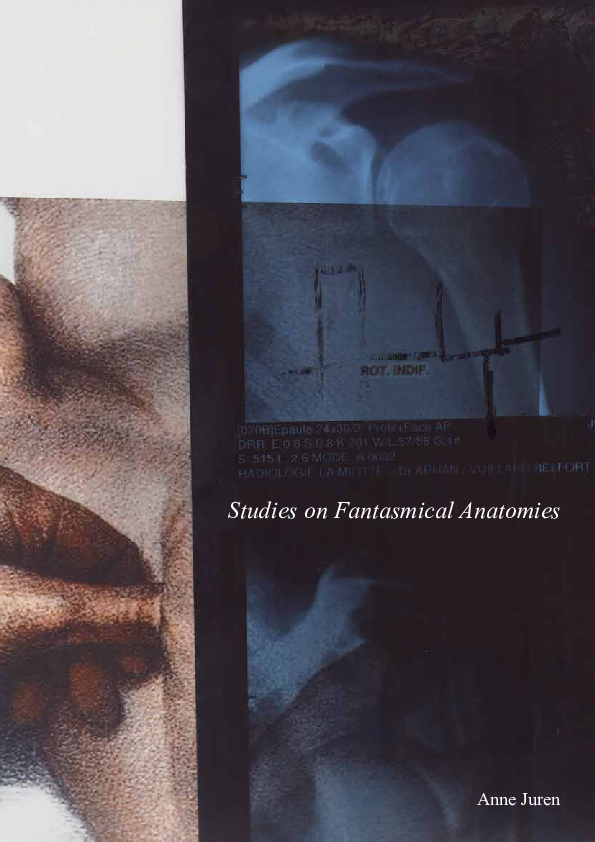Studies on Fantasmical Anatomies is an ongoing transdisciplinary artistic research, which encompasses the spectrum of experiences and practices that I have developed as a choreographer, dancer and Feldenkrais practitioner. My interest in anatomy and somatic practices grew out of multiple shoulder dislocations. The last dislocation happened in 2014 and, in retrospect, it functioned as a catalyst for this PhD and as one of its main methodologies. With the notion of “anatomies”, I’m more interested in operations on the body, than defining the body itself.
By drawing on various fields of knowledge – anatomy, psychoanalysis, feminist and queer theories, poetry and somatic practices – the research expands choreography towards disparate discourses, practices and treatments of the body. At the intersection of the therapeutic and the choreographic, the somatic and the poetic, I have developed several body-orientated practices based on Feldenkrais’ speculative use of language, imagination and touch.
The research has been articulated through three transversal movements. First, at the core of my practice, is the expansion and distortion of the Feldenkrais Method® from its initial somato-therapeutic goals into a poetic and speculative way of addressing the body. Revisiting and subverting Feldenkrais’ private session Functional Integration® and group class Awareness Through Movement®, I developed both one-on-one sessions and performances for larger public settings: Fantasmical Anatomies sessions and lessons.
Secondly, I propose experiences of diffraction, “blind gaze” and dissociation as a strategy for troubling the dominant regime of vision. In the Fantasmical Anatomies lessons, the first choreographic gesture is to invite the public to lie down and close their eyes. Withdrawing from the form of the spectacle, the choreography takes place in and across the bodies of the audience.
The third movement consists of the co-regulation of entities and dynamic relationships between the individual and the collective. Through the notion of “sensorial transference”, I have experimented with the possibility of sensing across bodies (“trans-interiority”) or through other bodies (proxy), and all of the ethical questions that such propositions give rise to.
Combining fantasy, the fantasme and phantasmagoria, I invented the word “fantasmical” to emphasize how the ability to imagine may create phantom limbs that are as concrete as pieces of bone. Equally imagined and bodily, these Fantasmical Anatomiescall into question some of the dichotomies that undergird Western cultures, such as representation and materiality, body and mind, idea and thing, fantasy and reality. Studies of Fantasmical Anatomies are simultaneously a set of practices, methods and places, in which the corps fantasmé is tangible.
Thesis fanzine
(PDF version) >>
Program of the live presentation at MDT >>
Atlas of Fantasmical Anatomies
(PDF version) >>
Thesis of Studies on Fantasmical Anatomies in form of a fanzine, distributed during the live presentation at MDT Stockholm, October 7-9, 2021
Program October 7
10:00-10.30 Welcome and Introduction
10:30-11:30 Critical Awareness Lesson
Critical Awareness Lessons are somatic lessons that expose the body to different modes of awareness, proposing various movements of navigation. The participants are invited to lie down on mattresses and close their eyes if they feel like it.
11:30-11:45 Break
11:45-13:00 Fantasmical Anatomies: studio installation and video works
13:00-14:00 Break
14:00-15:00 Sensorial Transference: lecture-performance and demonstration
Sensorial Transference is a session during which two or more patients can experience different possible interrelations between them. One person receives a treatment, acting as a representative for all bodies present in the space. The others lie next to the table and receive the treatment by proxy.
15:00-15:15 Break
15:15-16:30 Fantasmical Anatomies Lesson
Extending the format of Awareness Through Movement of the Feldenkrais Method®, Fantasmical Anatomies lessons suggest dysfunctional relations and speculative actions of the body using poetic and scientific-anatomical language, which can be taken in but also rejected. The Fantasmical Anatomies lessons experiment with how verbal, sonic and kinaesthetic languages affect the body and operate in a choreo-therapeutic context.
16:30-16:45 Break
16:45-18:30 Chromopoems: installation and 11 min performance for one spectator
Chromopoems are writings I did along my research translated into coloured lights. A Fantasmical Anatomies love poem is transformed into 24 theatrical lights decoding the letters’ sound signals into various colours. The resulting language of the light composition addresses the body of one spectator lying down in the middle of the space.
Program for the three-day live presentation at MDT. The footage (video, audio, photos) of the live lessons, installation and performances can be opened by clicking on the blue titles.
The Atlas of Fantasmical Anatomies is a single art book containing the material used for the process of this research. Studying anatomy also means confronting oneself with the different representations and images of the body and its anatomy in medical literature, atlases, and encyclopaedias. I've chosen to work on an atlas of anatomy since my research partly began with a critical engagement with how anatomy has been laid down in such publications to understand the different possible representations. Moreover, in anatomy, Atlas (C1) is the most superior cervical vertebra of the spine. It is located in the neck. It is named Atlas in Greek mythology because it supports the entire head, just as Atlas supported the globe.
Please note: this document is a facsimile of the artist book Atlas of Fantasmical Anatomies. It consists of 336 pages; therefore, it might take a while to open it.

